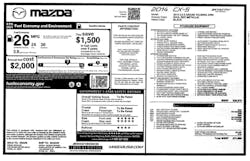NHTSA Proposes Adding ADAS Tech to its Feature Rating System
What you’ll learn:
- The NHTSA plans to incorporate four additional ADAS technologies in its rating system (NCAP).
- The series of questions the NHTSA is looking to get feedback on from the industry.
- Potential implementation of a new rating system.
New passenger vehicles are required to be labeled with safety rating information published by the National Highway Traffic Safety Administration (NHTSA) under its New Car Assessment Program (NCAP). NCAP is the U.S. Government’s premier consumer information program for evaluating vehicle safety performance. It’s one of several programs that NHTSA uses to fulfill its mission of reducing the number of fatalities, injuries, and economic losses that occur on U.S. roadways.
NHTSA plans to update NCAP by adding four advanced driver-assistance system (ADAS) capabilities to keep pace with evolving safety technologies and providing much-needed information to consumers. The ADAS technologies are pedestrian automatic emergency braking (PAEB), lane-keeping support (LKS), blind-spot warning (BSW) and blind-spot intervention (BSI).
NHTSA uses four prerequisites for selecting technologies to include in NCAP. They are:
- The technology addresses a safety need.
- System designs exist that can mitigate the safety problem.
- The technology provides the potential for safety benefits.
- A performance-based objective test procedure exists that can assess system performance.
NHTSA’s recent proposal also asks for comments on how best to develop a rating system for ADAS technologies. It further requests comments on potential approaches for conveying this information on vehicle window stickers (also known as Monroney labels, named after Almer Stilwell "Mike" Monroney, who served as a U.S. Senator from Oklahoma from 1951-1969), displayed on all new automobiles (see figure).
NHTSA currently conducts performance verification tests on four ADAS technologies for NCAP: forward collision warning (FCW), lane-departure warning (LDW), crash imminent braking (CIB), and dynamic brake support (DBS). CIB and DBS are collectively referred to as automatic emergency braking (AEB). Vehicles that are equipped with one or more of these systems and pass NCAP’s performance test requirements are listed as “Recommended” on NHTSA’s website.
When NHTSA first began recommending FCW and LDW systems for model year 2011 vehicles, the fitment rate for these systems was less than 0.2%. For model year 2018 vehicles, 38.3% were equipped with FCW, and 30.1% were equipped with LDW.
Industry Feedback
NHTSA also wants industry input on a number of key questions. For example:
- Do any aspects of NCAP’s current FCW, CIB, and/or DBS test procedure(s) need further refinement or clarification? If so, what refinements or clarifications are necessary, and why?
- Should NHTSA award credit solely to vehicles equipped with FCW systems that provide a passing audible alert? Or, should it also consider awarding credit to vehicles equipped with FCW systems that provide passing haptic alerts? Should certain haptic alert types be excluded from consideration (if NHTSA was to award credit to vehicles with haptic alerts that pass NCAP tests) because they may be a nuisance to drivers, making them more likely to disable the system? Do commenters believe that haptic alerts can be accurately and objectively assessed? Why or why not? Is it appropriate for NHTSA to refrain from awarding credit to FCW systems that provide only a passing visual alert? Why or why not?
- Whether it’s appropriate for NHTSA to accept only vehicle manufacturer test data that was derived from tests conducted with the test target specified in NCAP’s test procedures, and which adhered to NCAP test specifications in all other respects.
- Should curved roads can be considered for inclusion in NCAP test procedures to evaluate LKS systems objectively.
- NHTSA is requesting comment on adding Euro NCAP’s road-edge detection test to NCAP so that it may begin to address crashes that occur where lane markings may not be present.
- If NHTSA was to adopt the lane-keeping-assist test methods from the Euro NCAP protocol for its LKS test procedure, should the LDW test procedure be removed from its NCAP program entirely and an LDW requirement be integrated into the LKS test procedure instead? Why or why not?
- LKS system designs provide steering and/or braking to address lane departures (e.g., when a driver is distracted). To help re-engage a driver, should NHTSA specify that an LDW alert must be provided when the LKS is activated? Why or why not?
- Is the Euro NCAP maximum excursion limit of 1 ft. (0.3 m) over the lane marking (as defined with respect to the inside edge of the lane line) for LKS technology acceptable, or should the limit be reduced to account for crashes occurring on roads with limited shoulder width? If the tolerance should be reduced, what tolerance would be appropriate and why? Should this tolerance be adopted for LDW in addition to LKS? Why or why not?
- Among the ADAS technology NHTSA plans to include in its upgrade of NCAP is pedestrian automatic emergency braking (PAEB). NHTSA is seeking comment on integrating advanced lighting with the PAEB performance tests, and, in general, the testing of other ADAS technologies that may improve the forward camera’s ability to identify objects at night, and in turn, further improve overall ADAS performance
A New Rating System?
NHTSA is planning to create a rating system based on assessments related to the performance of ADAS technologies. Currently, NCAP places a check mark by the relevant ADAS technology on NHTSA’s website (www.nhtsa.gov) if two conditions are met: a vehicle is equipped with the safety technology recommended by NHTSA, and the system meets NCAP’s performance specifications.
Consumers are encouraged to look for vehicles equipped with ADAS that meet NCAP’s performance tests. These are intended to establish a minimum level of performance on which consumers can rely and compare among vehicles that have similar technologies
NCAP currently uses 1 to 5 stars to communicate vehicle crashworthiness ratings to consumers, with ratings for the individual tests and an overall rating. Given the familiarity that consumers have with NHTSA’s current 5-star ratings system, the Agency is considering the use of stars for a future ADAS rating system. However, it has some reservations about pursuing such an approach. A future star-based ADAS rating system could produce lower ratings for technologies than consumers are accustomed to seeing in crashworthiness and rollover resistance tests.
Another potential method of presenting ADAS rating information to consumers could be a three-tiered award system similar in concept to Olympic medals. Presumably, most consumers are already familiar with the designations of bronze, silver, and gold as increasingly more prestigious levels of achievement.
NHTSA could use points to convey ADAS rating information. Points could be used in lieu of stars or medals or in addition to these alternative rating communication concepts, and they may serve as the basis for any rating system approaches. One advantage of a points-based system is that it can provide improved delineation in ratings, thus benefiting consumers who may want to compare ratings between several vehicle models. However, a points-based system may cause consumer confusion if conveyed in addition to another communication rating concept, such as stars or medals.
NHTSA is seeking comment on the use of a potential points-based system to calculate future 5-star safety ratings for the crashworthiness testing program, if or when the agency decides to update that program. In this system, star ratings could be assigned directly from point values related to the results from crash test dummies rather than the existing system, which is based on probabilities of injury. The agency believes that this potential method would provide more flexibility in the future when updating the program.
For instance, new testing devices (e.g., crash test dummies), procedures, injury measurements, or other criteria could be added to the 5-star-ratings system. Points could be based on risk curve values or on criteria, such as reference values from existing federal regulations or other agency data. This points-based rating system approach would be similar to those used in other vehicle-safety consumer information programs such as IIHS and Euro NCAP.
V2X
In January 2017, NHTSA issued a Notice of Proposed Rulemaking (NPRM) for Federal Motor Vehicle Safety Standard: V2V Safety Communications (RIN 2127-AL55). If adopted, it would require vehicle-to-vehicle (V2V) technology on all new light-duty vehicles.
Since that time, technology and market circumstances have changed relative to:
- Available technology options that support device-to-device communications, including the development of advanced cellular technologies.
- Uncertainty concerning available spectrum to implement vehicle-to-everything (V2X) technologies.
- The development and deployment of V2X applications by both commercial and government entities.
While NHTSA continues to consider whether regulatory approaches for advancing V2V deployment is appropriate, given these changes, it’s also evaluating the potential inclusion of V2X in NCAP.
NHTSA has tentatively concluded that V2V meets its prerequisites for selecting technologies to include in NCAP. As such NHTSA is soliciting comment on its initiative related to V2X, specifically the appropriateness of NCAP adopting such technology in the future.
Where to Send Comments
Comments submitted will help NHTSA make informed decisions. The URL of the Federal Rulemaking Portal is http://www.regulations.gov. Follow the online instructions for submitting comments.
Your comments must be written and in English. To ensure that your comments are filed correctly in the docket, please include the docket number: NHTSA-2021-0002. Comments must not be more than 15 pages long. NHTSA established this limit to encourage you to write your primary comments in a concise fashion. However, you may attach necessary additional documents to your comments. There’s no limit on the length of the attachments.

